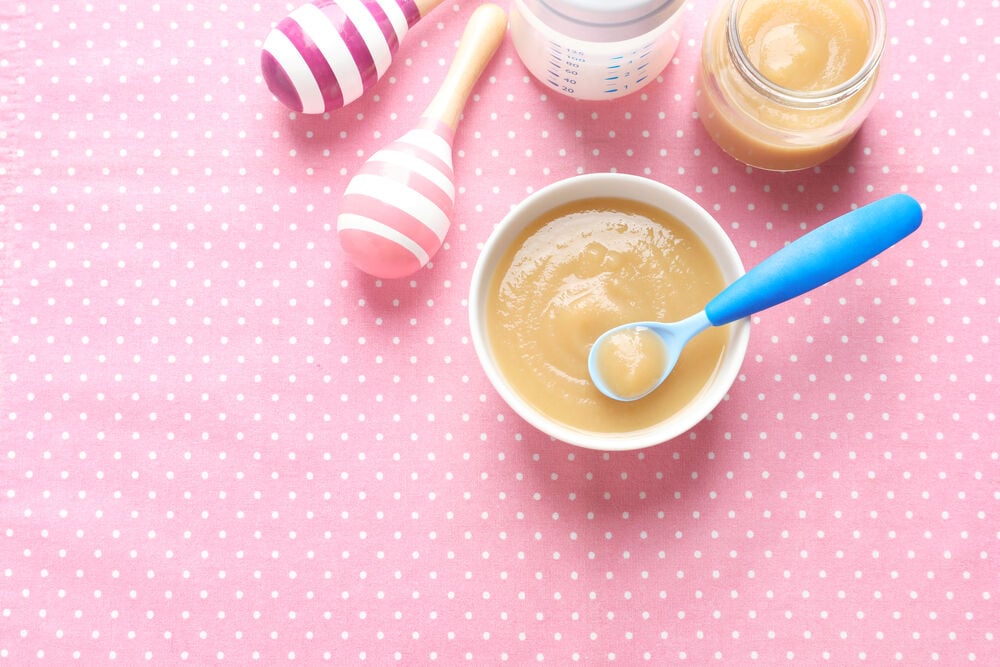Experts recommend breast milk to meet all of babies’ needs for the first six months of their life. But what happens after that? What does feeding a 7-month-old look like? We’ve got everything you need to know about feeding your 7-month-old baby, including what they can eat and an appropriate 7-month-old feeding schedule.
-
Tracking cycle
-
Getting pregnant
-
Pregnancy
-
Help Center
-
Flo for Partners
-
Anonymous Mode
-
Flo app reviews
-
Flo Premium New
-
Secret Chats New
-
Symptom Checker New
-
Your cycle
-
Health 360°
-
Getting pregnant
-
Pregnancy
-
Being a mom
-
LGBTQ+
-
Quizzes
-
Ovulation calculator
-
hCG calculator
-
Pregnancy test calculator
-
Menstrual cycle calculator
-
Period calculator
-
Implantation calculator
-
Pregnancy weeks to months calculator
-
Pregnancy due date calculator
-
IVF and FET due date calculator
-
Due date calculator by ultrasound
-
Medical Affairs
-
Science & Research
-
Pass It On Project New
-
Privacy Portal
-
Press Center
-
Flo Accuracy
-
Careers
-
Contact Us
7-Month-Old Feeding Schedule: Baby Menu

Every piece of content at Flo Health adheres to the highest editorial standards for language, style, and medical accuracy. To learn what we do to deliver the best health and lifestyle insights to you, check out our content review principles.
Feeding a 7-month-old: Introducing solid foods
Breastfeeding helps reduce babies’ risk of being exposed to enteropathogens and decreases the risk of infection (pneumonia, meningitis, bacterial, urinary tract infections, and necrotizing enterocolitis), offers higher levels of immunologic factors, and lowers the risk of sudden infant death syndrome. Children who were breastfed are also less likely to be obese.
Breastfeeding can also benefit the mother’s health. It elevates maternal oxytocin levels, decreases postpartum bleeding, helps the uterus shrink faster, decreases menstrual blood loss, improves bone mineralization, decreases the risk of ovarian and breast cancer, increases mother-baby bonding, and saves on the costs of formula.
After six months, breastfed babies require more energy from iron-rich food sources, fluoride, and around 400 IU/day of vitamin D to continue to grow and develop. While some parents continue breastfeeding their child at seven months, it’s typically a good time to introduce complementary solid foods into a baby’s diet.
Before starting a solid food feeding schedule for a 7-month-old baby, it’s important to be sure they are physically able to eat solid foods. A baby is ready to eat solid foods if they can:
- Sit upright on their own
- Hold their head up unassisted
- Open their mouth when food is presented to them
- Swallow easily
Another good guideline for knowing if a baby is ready to eat solids is if they have doubled their birth weight. This generally indicates that their digestive system is sufficiently developed to process solid foods.
These are just guidelines, and it’s important to speak with the baby’s pediatrician to be sure that they are ready for solid food.
Solid foods appropriate for 7-month-old babies

What kinds of solids are best for feeding a 7-month-old? The baby’s food should be as nutritious and unprocessed as possible — and easy to eat. The food should be soft enough for the baby to mash with their gums, as not all of their teeth will have come in by the seventh month. Often, they only have the lower central incisors at this age. At seven months old, boys need about 825 calories per day, and girls need about 765 calories per day.
Here are some solid foods to try introducing:
- Pureed baby food from a jar or pouch, without added sugar or preservatives
- Cooked mashed foods like potatoes, squash, or carrots
- Whole grain, iron-fortified baby cereals
- Pureed fruits and vegetables (cooked)
- Soft or mashed legumes, such as split peas or lentils
A 7-month-old’s feeding plan should not include:
- Honey, which has been linked with infant botulism (a rare but potentially fatal disease)
- Cow’s milk, which can be difficult to digest and could trigger an allergic reaction
- Hard nuts, small fruits, grapes, gum, and candy, which can be choking hazards
- Processed foods and food with added sugars, as they are unhealthy and can cause indigestion and diarrhea
The baby’s health care provider can advise on what the baby can or can’t eat.
Once the baby begins eating solid foods, they can and should continue to breastfeed or bottle feed stored breast milk or formula. People who are taking certain medications can talk to a health care provider about whether or not it’s safe to breastfeed.
Sample feeding schedule for 7-month-old baby
After learning what kinds of foods a baby can try, many parents ask: What is a good feeding schedule for a 7-month-old? We’ve prepared a sample feeding schedule for a 7-month-old baby.
A 7-month-old feeding schedule for a breastfed baby will look slightly different than one for a formula-fed one. Breastfed babies should continue to breastfeed every three to four hours and eat solid food three times per day, as follows:
- Early morning: Breastfeed when the baby first wakes up.
- Morning: Breastfeed the baby just before feeding them a small portion of solid foods (four to six ounces) for breakfast.
- Early afternoon: Breastfeed the baby after their morning nap and before feeding them a small portion of solid foods for lunch.
- Afternoon: Breastfeed the baby before and after their mid-day nap.
- Early evening: Breastfeed the baby before serving them a small portion of solid foods at dinner time.
- Evening: Breastfeed the baby before putting them down to bed.
A 7-month-old baby feeding schedule for formula-fed babies may look a little different. Formula-fed babies should be given 30–32 ounces of formula per day spread over three to five feedings, with solid food given three times per day.
Take a quiz
Find out what you can do with our Health Assistant
7-month-old feeding tips
Feeding a 7-month-old baby takes time, patience, and lots of trial and error. These tips can help gradually increase the amount of solid food in a baby’s diet:
- Start small, offering one tablespoon at a time and working up to 12 tablespoons of solid food with each meal, depending on how hungry the baby is.
- Limit finger foods that require more dexterity.
- Try to keep a consistent schedule. Solid foods should be served at the table and fed at regular meal times, like breakfast, lunch, and dinner.
- Introduce new foods individually and about a week apart in order to identify any allergies and intolerance the baby may have. It’s best to introduce foods from most bland to sweetest.
- Offer foods with different textures, like mashed, pureed, ground, and soft solids.
- Start with pureed foods, working up to mashed foods as the baby’s teeth grow and they become more comfortable with chewing.
- Avoid serving hard, round, or sticky foods that could pose a choking hazard. Cut solids into pieces smaller than ½ inch.
Many parents know how challenging it can be to keep to a rigid feeding schedule for a 7-month-old. Many parents find that their babies don’t stick to a typical schedule. Noticing if they lean into the spoon or reach for food on the plate can help determine if they are hungry. If they are, they’ll likely show it.
For more great tips on raising a baby, check out Flo.health.


Hey, I'm Anique
I started using Flo app to track my period and ovulation because we wanted to have a baby.


The Flo app helped me learn about my body and spot ovulation signs during our conception journey.


I vividly
remember the day
that we switched
Flo into
Pregnancy Mode — it was
such a special
moment.
Real stories, real results
Learn how the Flo app became an amazing cheerleader for us on our conception journey.




